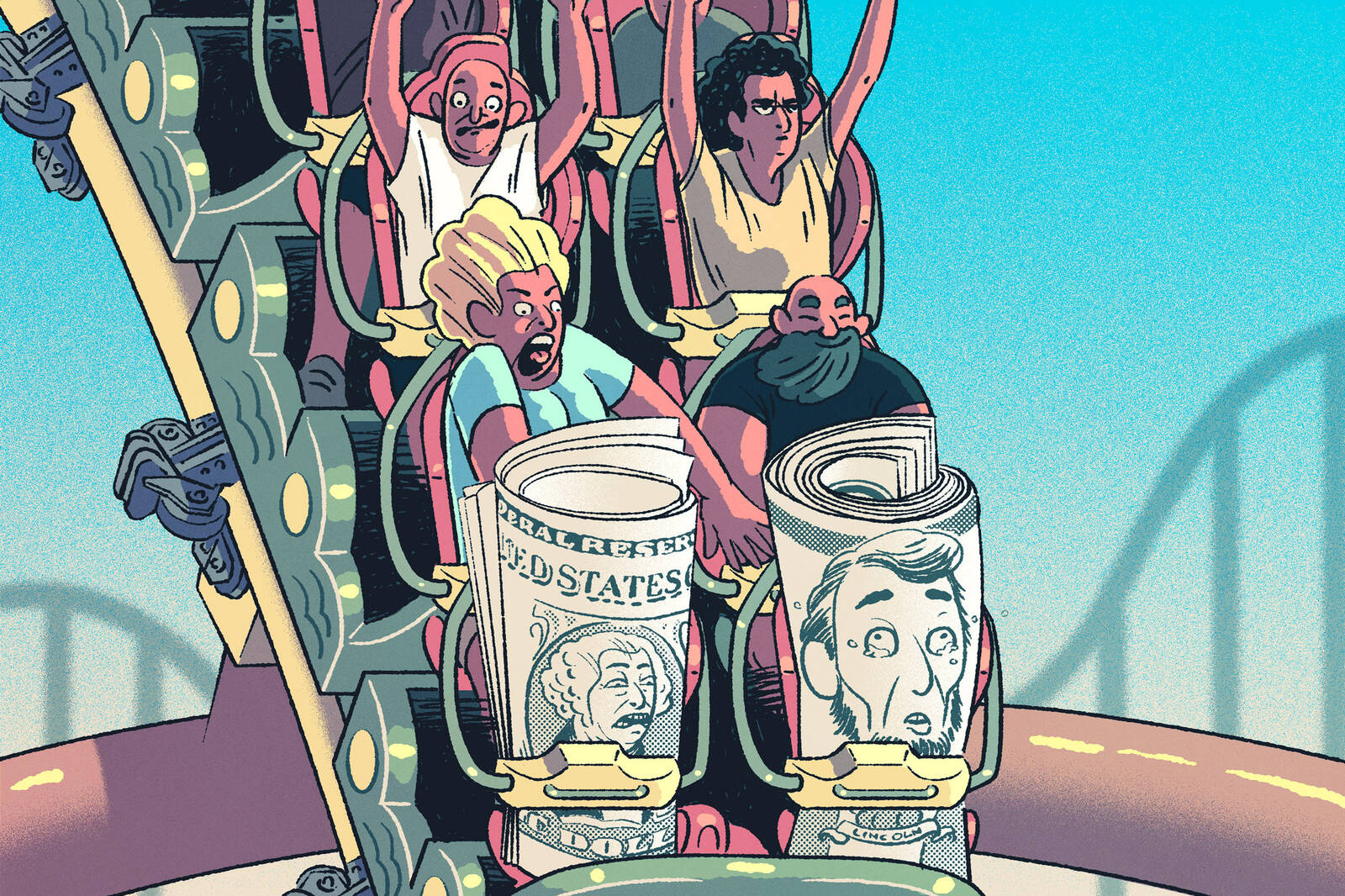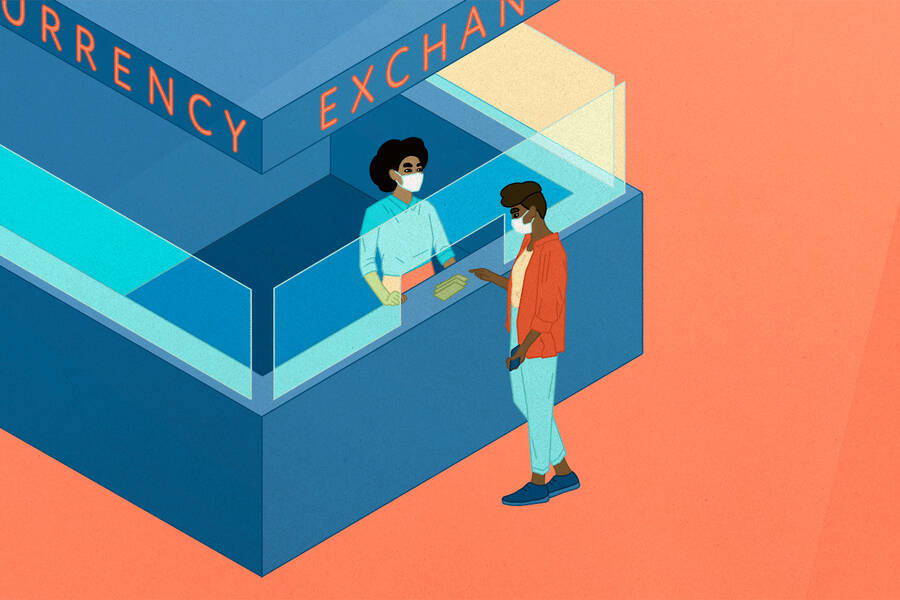Finance & Accounting Jun 16, 2025
What Makes the U.S. Dollar So Special?
Despite its ups and downs, the dollar has maintained global dominance for years. New research shows why that is—and why it might not last forever.

Michael Meier
The U.S. dollar, one of the world’s most widely sought-after assets, saw its value decline by as much as 10 percent in the first half of 2025, inviting speculation about the end of its global dominance.
Despite the concern, it’s actually not unusual for the dollar’s value to fluctuate. One need only look back to 2017 to see a similar drop. Why does the value of the U.S. dollar rise and fall over time?
“It’s an age-old question,” says Zhengyang Jiang, an associate professor of finance at Kellogg. “An important angle is that the [dollar] exchange rate is a safe-haven currency that moves with business cycles.”
But this conventional wisdom is difficult to square with decade-long trends, he adds. Furthermore, explanations of these longer-term shifts tend to rely more on “useful narratives”—like changes in monetary policy and global savings glut—than real-world data.
Jiang and his collaborators, Robert J. Richmond of New York University and Tony Zhang of the Federal Reserve Board, took a different approach to answering this question. Using a valuation model based on two decades’ worth of data from the International Monetary Fund, the researchers were able to break down the strength of the dollar into simple, quantifiable components, or “primitives”—and show which of them had the most influence over time.
“We’re not the first ones to study dollar strength” in these terms, Jiang says. “But we are interested in a comprehensive analysis that quantifies how multiple primitives come together to explain the dollar’s behavior.”
The researchers found that more than 90 percent of the dollar’s strength comes from just two components: global savings (the amount of currency being held by companies, central banks, and other major financial institutions) and investor demand (the market’s overall appetite for buying dollar-based assets, like U.S. Treasury bonds).
The model also showed what would happen if investor demand were to shift. Surprisingly, a sudden sell-off from one major economy, like China or Europe, wouldn’t weaken the dollar by much at all.
However, a widespread dip in demand for U.S. assets would cause the dollar to depreciate by 25 percent. This could threaten the dollar’s dominant status as the world’s reserve currency. The big question is whether it will happen.
Keeping it simple
The researchers’ model assumes that countries and financial institutions view the U.S. dollar the same way they would any other investment asset. In other words, they buy, sell, trade, and hold the dollar and dollar-based assets much like stock in a company.
This approach allowed the researchers to use standard economic tools to break down the dollar’s strength into three components. The first, monetary policy, includes the interest rates set by central banks. The second is savings, which refers to the portfolio of wealth looking for investments around the world. The third, and simplest, component is demand: How desirable is the dollar to international investors?
Global confidence in Treasury bonds is wavering, which has “likely diminished the measurable specialness of the dollar in the international financial market.”
—
Zhengyang Jiang
Jiang and his collaborators applied this model to data from the International Monetary Fund, which tracked currency exchange rates, dollar-based asset prices, and portfolio allocations—that is, how much a country or major financial institutions had invested in the U.S. dollar—between 2002 and 2021.
“By putting these variables together, we can say that X percent of the dollar’s strength is explained by this component, and Y percent is explained by that component,” Jiang says. “Starting with a simple and coherent framework is what allows us to break it down into these ingredients.”
Strength through demand
According to the researchers’ model, long-term swings in the strength of the dollar are dominated by two factors: shifts in investor demand, which explain 55 percent of the dollar’s strength, and global savings, which account for 36 percent.
Much like a blue-chip stock, the dollar’s value appreciates when more companies and countries consider it a desirable investment. Holding savings in U.S. currency strengthens the dollar, too, by bolstering its global reputation as a stable store of value.
Monetary policy, however, had a surprisingly negligible effect on the dollar’s long-term strength. That’s not to say it doesn’t matter at all. According to the model, if the Federal Reserve were to raise U.S. interest rates by one percentage point, the dollar could be expected to appreciate by 3.3 percent. But these shifts “matter on a a year-to-year basis,” Jiang says. “What we want to add to the conventional wisdom [about the strength of the dollar] is that interest-rate gaps between the U.S. and other countries tend to converge over the long run.”
Identifying demand as the biggest determinant of the dollar’s strength also let the researchers explore what would happen if that demand suddenly changed. China, for example, has been one of the largest global investors in the dollar for the past two decades and currently holds $765 billion in U.S. Treasury bonds and other dollar-based securities. In the face of a demand shock—like China’s central bank liquidating its holdings all at once—would the dollar’s value crater?
Surprisingly, no. According to the researchers’ model, this kind of unilateral sell-off would only depreciate the dollar by 2.5 percent. Even if it was the entire European Union doing the selling instead of China, the effect would be similarly low. And if Japan or Canada did so, the depreciating effect on the dollar would be even smaller—less than 1 percent.
The reason, according to Jiang, is simple: if one country (or major economic bloc) dumps the dollar, others will quickly buy it back up.
“The demand for U.S. [currency] assets is particularly elastic,” he explains. “If China or Europe sells all their holdings, what will happen is that these dollar assets will become available on the market at a slight discount. And foreigners have a high willingness to substitute towards those assets when they’re available at a discount.” Jiang and his coauthors call this strong global preference for dollar assets “specialness.”
But if that specialness changes, the dollar is in trouble. “You don’t want any correlated sales to happen,” Jiang says. “That would result in a severe depreciation.”
Indeed, the researchers’ model showed that if demand for U.S. currency suddenly slackened across many countries, the dollar’s long-term strength would be sapped by at least 25 percent.
The end of an era?
This sustained depreciation has happened to the dollar before, notably in the years preceding the 2008 global financial crisis.
Between 2002 and 2007, the dollar experienced a 25 percent depreciation, which the model confirmed was mostly due to an increased global appetite for risky foreign investments. The dollar, seen as stable and safe, was less appealing to investors during that time. But during the financial crisis, from 2008 to 2009, a “flight to safety” among investors briefly reversed that trend, strengthening the dollar. And as the global economy eventually recovered after 2010, so did its appetite for risk. Post crisis, dollar-based assets were seen as riskier investments than before; thus began a decade-long strengthening of the dollar, “like any other investment boom,” Jiang says.
Amid the dollar’s ups and downs during the two-decade timespan the researchers studied for their model, the dollar’s specialness remained relatively constant. This specialness is what underpins the dollar’s long-held status as a stable reserve currency for the global economy, they say.
Then again, no law of nature states that the dollar should enjoy this privileged status forever. The Dutch guilder lost its specialness to the British pound sterling in the 19th century, which in turn was eclipsed by the U.S. dollar after World War II. In both cases, a widespread loss of investor confidence signaled the beginning of the end for the reigning reserve currency. The fall in these cases also coincided with fiscal expansions that government revenues could not meet.
In a follow-up paper, Jiang notes that tariff announcements by the Trump administration were met with a “surprising” 6.5 percent depreciation in the dollar from April 1 to 21 and a sudden drop in the relative value of U.S. Treasury bonds, despite rising interest rates and market volatility.
In the face of market volatility, global investors usually seek the dollar out as a safe haven. “This time,” Jiang and his coauthors write, “is different.” Global confidence in Treasury bonds is wavering, which has “likely diminished the measurable specialness of the dollar in the international financial market.”
If true, this is exactly the kind of demand shock that could cause a “severe depreciation” of the dollar, according to Jiang’s model. So, is the dollar’s dominance really in sunset, like the guilder and pound before it? Jiang says it’s still too early to tell.
“The market has already responded to the shock,” he says. “It’s unclear if this is going to be permanent or transitory.”
John Pavlus is a writer and filmmaker focusing on science, technology, and design topics. He lives in Portland, Oregon.
Jiang, Zhengyang, Robert J. Richmond, and Tony Zhang. 2025. “Understanding the Strength of the Dollar.” Journal of Financial Economics.
Jiang, Zhengyang, Arvind Krishnamurthy, Hanno Lustig, Robert Richmond, and Chenzi Xu. 2025. “Dollar Upheaval: This Time Is Different.” Working paper.



